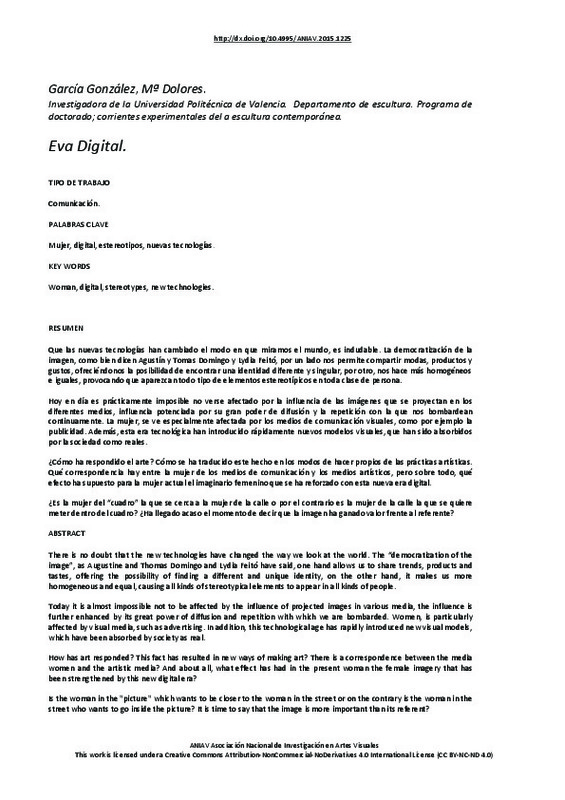JavaScript is disabled for your browser. Some features of this site may not work without it.
Buscar en RiuNet
Listar
Mi cuenta
Estadísticas
Ayuda RiuNet
Admin. UPV
"Eva" Digital
Mostrar el registro sencillo del ítem
Ficheros en el ítem
| dc.contributor.author | García González, María Dolores
|
es_ES |
| dc.date.accessioned | 2017-10-05T07:46:03Z | |
| dc.date.available | 2017-10-05T07:46:03Z | |
| dc.date.issued | 2015-11-26 | |
| dc.identifier.isbn | 9788490483411 | |
| dc.identifier.uri | http://hdl.handle.net/10251/88767 | |
| dc.description.abstract | [EN] There is no doubt that the new technologies have changed the way we look at the world. The “democratization of the image”, as Augustine and Thomas Domingo and Lydia Feitó have said, one hand allows us to share trends, products and tastes, offering the possibility of finding a different and unique identity, on the other hand, it makes us more homogeneous and equal, causing all kinds of stereotypical elements to appear in all kinds of people. Today it is almost impossible not to be affected by the influence of projected images in various media, the influence is further enhanced by its great power of diffusion and repetition with which we are bombarded. Women, is particularly affected by visual media, such as advertising. In addition, this technological age has rapidly introduced new visual models, which have been absorbed by society as real. How has art responded? This fact has resulted in new ways of making art? There is a correspondence between the media women and the artistic media? And about all, what effect has had in the present woman the female imagery that has been strengthened by this new digital era? Is the woman in the "picture" which wants to be closer to the woman in the street or on the contrary is the woman in the street who wants to go inside the picture? It is time to say that the image is more important than its referent? | es_ES |
| dc.description.abstract | [ES] Que las nuevas tecnologías han cambiado el modo en que miramos el mundo, es indudable. La democratización de la imagen, como bien dicen Agustín y Tomas Domingo y Lydia Feitó, por un lado nos permite compartir modas, productos y gustos, ofreciéndonos la posibilidad de encontrar una identidad diferente y singular, por otro, nos hace más homogéneos e iguales, provocando que aparezcan todo tipo de elementos estereotípicos en toda clase de persona. Hoy en día es prácticamente imposible no verse afectado por la influencia de las imágenes que se proyectan en los diferentes medios, influencia potenciada por su gran poder de difusión y la repetición con la que nos bombardean continuamente. La mujer, se ve especialmente afectada por los medios de comunicación visuales, como por ejemplo la publicidad. Además, esta era tecnológica han introducido rápidamente nuevos modelos visuales, que han sido absorbidos por la sociedad como reales. ¿Cómo ha respondido el arte? Cómo se ha traducido este hecho en los modos de hacer propios de las prácticas artísticas. Qué correspondencia hay entre la mujer de los medios de comunicación y los medios artísticos, pero sobre todo, qué efecto ha supuesto para la mujer actual el imaginario femenino que se ha reforzado con esta nueva era digital. ¿Es la mujer del “cuadro” la que se cerca a la mujer de la calle o por el contrario es la mujer de la calle la que se quiere meter dentro del cuadro? ¿Ha llegado acaso el momento de decir que la imagen ha ganado valor frente al referente? | es_ES |
| dc.format.extent | 10 | es_ES |
| dc.language | Español | es_ES |
| dc.publisher | Editorial Universitat Politècnica de València | es_ES |
| dc.relation.ispartof | II CONGRESO INTERNACIONAL DE INVESTIGACIÓN EN ARTE VISUALES | es_ES |
| dc.rights | Reconocimiento - No comercial - Sin obra derivada (by-nc-nd) | es_ES |
| dc.subject | Arte | es_ES |
| dc.subject | Producción artística | es_ES |
| dc.subject | Estética | es_ES |
| dc.subject | Teoría del Arte | es_ES |
| dc.subject | Gestión cultural | es_ES |
| dc.subject | Educación artística | es_ES |
| dc.subject | Investigación artística | es_ES |
| dc.title | "Eva" Digital | es_ES |
| dc.type | Capítulo de libro | es_ES |
| dc.type | Comunicación en congreso | es_ES |
| dc.identifier.doi | 10.4995/ANIAV2015.1225 | |
| dc.rights.accessRights | Abierto | es_ES |
| dc.contributor.affiliation | Universitat Politècnica de València. Departamento de Escultura - Departament d'Escultura | es_ES |
| dc.contributor.affiliation | Universitat Politècnica de València. Facultad de Bellas Artes - Facultat de Belles Arts | es_ES |
| dc.description.bibliographicCitation | García González, MD. (2015). "Eva" Digital. En II CONGRESO INTERNACIONAL DE INVESTIGACIÓN EN ARTE VISUALES. Editorial Universitat Politècnica de València. 282-291. https://doi.org/10.4995/ANIAV2015.1225 | es_ES |
| dc.description.accrualMethod | OCS | es_ES |
| dc.relation.conferencename | II Congreso Internacional de Investigación en Artes Visuales. |< real | virtual >| ANIAV2015 | es_ES |
| dc.relation.conferencedate | July 09-10,2015 | es_ES |
| dc.relation.conferenceplace | Valencia, Spain | es_ES |
| dc.relation.publisherversion | http://ocs.editorial.upv.es/index.php/ANIAV/ANIAV2015/paper/view/1225 | es_ES |
| dc.description.upvformatpinicio | 282 | es_ES |
| dc.description.upvformatpfin | 291 | es_ES |
| dc.type.version | info:eu-repo/semantics/publishedVersion | es_ES |
| dc.relation.pasarela | OCS\1225 | es_ES |








